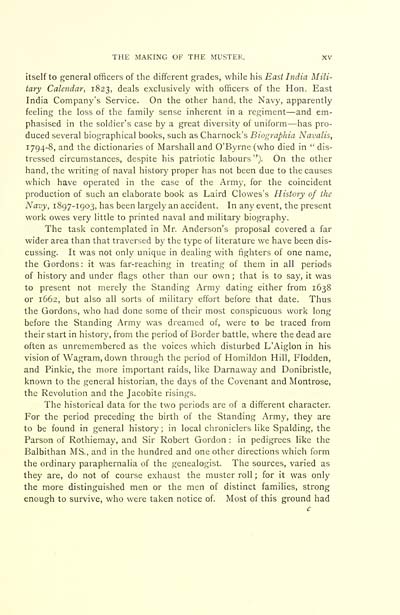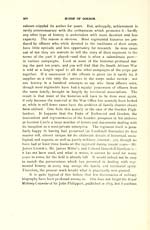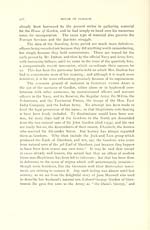New Spalding Club > House of Gordon > Gordons under arms
(25) Page xv
Download files
Complete book:
Individual page:
Thumbnail gallery: Grid view | List view

THE MAKING OF THE MUSTER. XV
itself to general officers of the different grades, while his East India Mili-
tary Calendar, 1823, deals exclusively with officers of the Hon. East
India Company's Service. On the other hand, the Navy, apparently
feeling the loss of the family sense inherent in a regiment — and em-
phasised in the soldier's case by a great diversity of uniform — has pro-
duced several biographical books, such as Charnock's Bio^raphia Navalis,
1794-8, and the dictionaries of Marshall and O'Byrne (who died in " dis-
tressed circumstances, despite his patriotic labours "). On the other
hand, the writing of naval history proper has not been due to the causes
which have operated in the case of the Army, for the coincident
production of such an elaborate book as Laird Clowes's History of the
Navy, 1897-1903, has been largely an accident. In any event, the present
work owes very little to printed naval and military biography.
The task contemplated in Mr. Anderson's proposal covered a far
wider area than that traversed by the type of literature we have been dis-
cussing. It was not only unique in dealing with fighters of one name,
the Gordons: it was far-reaching in treating of them in all periods
of history and under flags other than our own ; that is to say, it was
to present not merely the Standing Army dating either from 1638
or 1662, but also all sorts of military effort before that date. Thus
the Gordons, who had done some of their most conspicuous work long
before the Standing Army was dreamed of, were to be traced from
their start in history, from the period of Border battle, where the dead are
often as unremembered as the voices which disturbed L'Aiglon in his
vision of Wagram, down through the period of Homildon Hill, Flodden,
and Pinkie, the more important raids, like Darnaway and Donibristle,
known to the general historian, the days of the Covenant and Montrose,
the Revolution and the Jacobite risings.
The historical data for the two periods are of a different character.
For the period preceding the birth of the Standing Army, they are
to be found in general history ; in local chroniclers like Spalding, the
Parson of Rothiemay, and Sir Robert Gordon : in pedigrees like the
Balbithan MS., and in the hundred and one other directions which form
the ordinary paraphernalia of the genealogist. The sources, varied as
they are, do not of course e.xhaust the muster roll ; for it was only
the more distinguished men or the men of distinct families, strong
enough to survive, who were taken notice of. Most of this ground had
itself to general officers of the different grades, while his East India Mili-
tary Calendar, 1823, deals exclusively with officers of the Hon. East
India Company's Service. On the other hand, the Navy, apparently
feeling the loss of the family sense inherent in a regiment — and em-
phasised in the soldier's case by a great diversity of uniform — has pro-
duced several biographical books, such as Charnock's Bio^raphia Navalis,
1794-8, and the dictionaries of Marshall and O'Byrne (who died in " dis-
tressed circumstances, despite his patriotic labours "). On the other
hand, the writing of naval history proper has not been due to the causes
which have operated in the case of the Army, for the coincident
production of such an elaborate book as Laird Clowes's History of the
Navy, 1897-1903, has been largely an accident. In any event, the present
work owes very little to printed naval and military biography.
The task contemplated in Mr. Anderson's proposal covered a far
wider area than that traversed by the type of literature we have been dis-
cussing. It was not only unique in dealing with fighters of one name,
the Gordons: it was far-reaching in treating of them in all periods
of history and under flags other than our own ; that is to say, it was
to present not merely the Standing Army dating either from 1638
or 1662, but also all sorts of military effort before that date. Thus
the Gordons, who had done some of their most conspicuous work long
before the Standing Army was dreamed of, were to be traced from
their start in history, from the period of Border battle, where the dead are
often as unremembered as the voices which disturbed L'Aiglon in his
vision of Wagram, down through the period of Homildon Hill, Flodden,
and Pinkie, the more important raids, like Darnaway and Donibristle,
known to the general historian, the days of the Covenant and Montrose,
the Revolution and the Jacobite risings.
The historical data for the two periods are of a different character.
For the period preceding the birth of the Standing Army, they are
to be found in general history ; in local chroniclers like Spalding, the
Parson of Rothiemay, and Sir Robert Gordon : in pedigrees like the
Balbithan MS., and in the hundred and one other directions which form
the ordinary paraphernalia of the genealogist. The sources, varied as
they are, do not of course e.xhaust the muster roll ; for it was only
the more distinguished men or the men of distinct families, strong
enough to survive, who were taken notice of. Most of this ground had
Set display mode to: Large image | Transcription
Images and transcriptions on this page, including medium image downloads, may be used under the Creative Commons Attribution 4.0 International Licence unless otherwise stated. ![]()
| Publications by Scottish clubs > New Spalding Club > House of Gordon > Gordons under arms > (25) Page xv |
|---|
| Permanent URL | https://digital.nls.uk/79780997 |
|---|
| Description | Volumes 47-53 are uniform with but not part of the club's series. |
|---|---|

